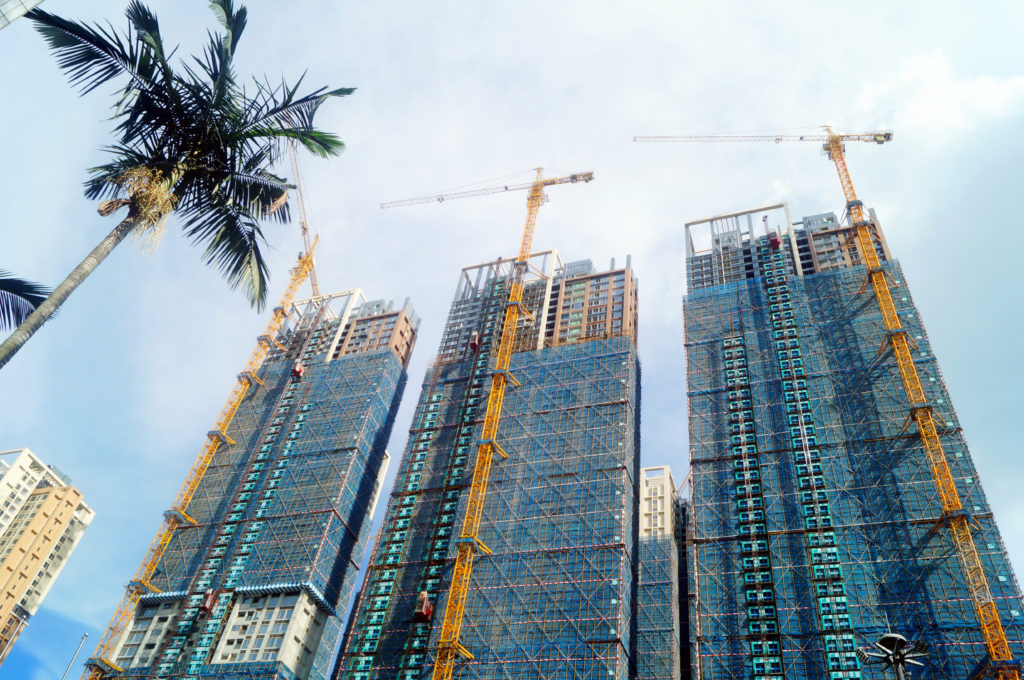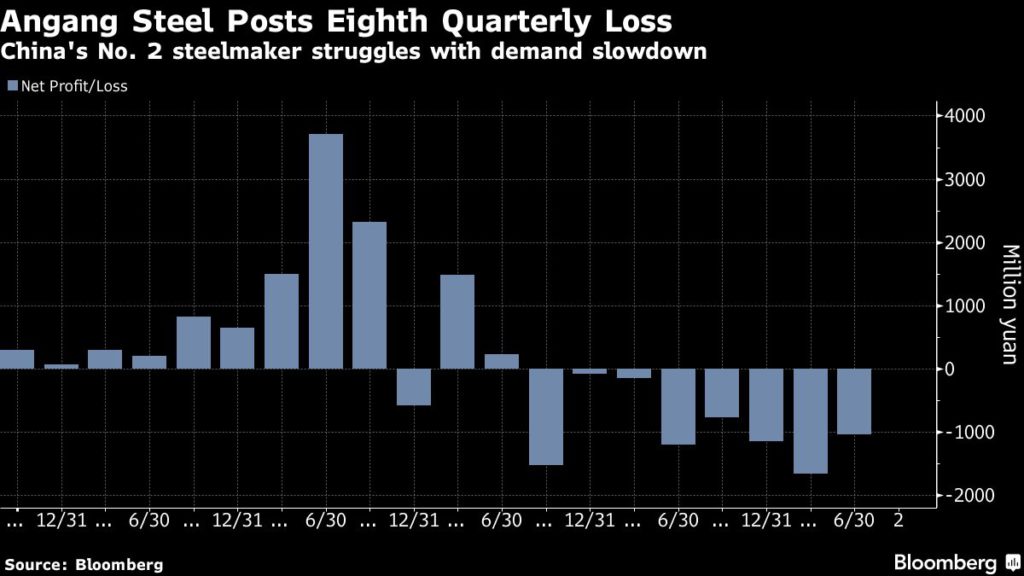...Iron Ore price slumped -4% below $100 to $96.95.
....Copper also fell -3.66% to $3.99
....this thread had warned you on BHP since when it was $50. The decline will get worse after ex-div.
Iron ore price tumbles back below $100 as China property woes deepen
Bloomberg News | September 2, 2024 | 9:13 am Markets China Iron Ore
Shenzhen, China. Stock image.
Iron ore slumped back below $100 a ton, snuffing out a rebound, as pessimism over China’s economic prospects again weighed on industrial commodities.
The steel-making material rose almost 10% over the past two weeks on tentative signs that the worst of China’s summer steel rout might be over. But soft manufacturing activity and another round of downbeat news from the country’s property sector stung prices on Monday.
A protracted real estate downturn has squeezed Chinese steel demand and triggered a wave of losses across the industry. At a gathering in Beijing last week, executives from 18 of the country’s biggest producers vowed more “self-discipline” to alleviate a glut of the metal.
Iron ore futures fell 3.9% to $97.10 a ton in Singapore by 3:47 p.m. local time. Steel futures in Shanghai declined.
Factory activity in China contracted for a fourth straight month in August, while the latest property sales figures showed a worsening residential slump. One of the nation’s biggest developers posted its first loss in more than two decades.
It’s “difficult to fundamentally improve the predicament of the iron and steel market” while supply is greater than demand, Angang Steel Co. — the listed arm of the country’s second-biggest steel producer — said in its earnings announcement, which revealed an eighth straight quarterly loss.
Last week’s Beijing summit was convened by the China Iron & Steel Association to address growing pressures on the industry that still makes about 1 billion tons a year. The association said steelmakers needed to avoid “involution” — a phrase denoting destructive competition that’s become popular in China in recent years.
The industry is used to operating under conditions of continuous growth, and ways to counter lower demand are still being worked out by companies, industry groups, and the government, the association said.
Few Chinese steelmakers have made a profit in 2024 as prices plunge, and there’s growing calls for action to stem an oversupply crisis. Angang racked up a net loss of almost 1 billion yuan ($140 million) in the second quarter, about 15% less than a year earlier.
Base metals also joined broad declines across financial markets in Asia, with zinc — often tied to sentiment in China’s steel market — leading losses with a drop of 1.5%. Copper fell 0.2% and aluminum declined for a fourth day.
‘Collapsing’: Inside Australia’s iron ore disaster amid huge China announcement
The unsteady future of former cash cow iron ore has transfixed Australians for more than a year. But now reality has finally hit. Hard.
Jamie Seidel
5 min read
August 20, 2024 - 7:46AM
Soaring supply. Surging stockpiles. Collapsing demand. The unsteady future of iron ore has held Australia transfixed in its headlights for more than a year.
Now reality has hit. Hard.
Benchmark prices for the commodity fell about 9 per cent last week.
It should have come as a surprise to no one.
The price tumble began after top steelmaking firm Baowu finally admitted there would be no significant stimulus package from its Chinese Communist Party owners.
On Wednesday, its chairman Hu Vangming warned that the “winter” of steel demand from China’s struggling construction industry would be “longer, colder and more difficult than we expected”.
This prompted spot prices for the raw ingredient of steel, iron ore, to nosedive to as low as $US81.8 a tonne Friday.
It started the year at about $136 a tonne.
Australia is the world’s largest exporter of iron ore. It contributed about $136 billion to national revenue in 2023.
In April, Treasurer Jim Chalmers warned that the commodity’s uncertain future could produce a $9 billion hole in the national budget over the next four years. Now he says that warning has come true, and any further deterioration in the price could wipe an extra $3 billion from those estimates.
“This is exactly why we take such a cautious and conservative approach to Treasury’s forecasts for resource prices and revenue,” Dr Chalmers told The Australian today.
“We’re following these developments very closely because of their potential impact on our economy and our budget.”
But the poor health of China’s economy is not the sole cause of Australia’s woes.
A new report from the Institute for Energy Economics and Financial Analysis (IEEFA) warns the global steel industry is undergoing a fundamental shift.
“Simply digging and shipping has worked very well for Australia in recent decades,” the report reads.
“[But] a revenue hit is approaching for Australia’s biggest export, and there is growing international competition in the high-grade ore and green iron space. Australia needs to seriously consider, and plan for, what its iron ore sector needs to look like from the next decade onwards.”
When China sneezes …
China is the world’s biggest consumer of steel.
China is the world’s biggest steel maker.
Australia is China’s largest supplier of iron ore.
Beijing has repeatedly stated over the past 18 months that it would not inject artificial stimulus into its already saturated residential and commercial building industries once again.
Chairman Xi Jinping has instead insisted on a new economic focus towards “high-quality development for the wellbeing of the people”. That’s despite the collapse of China’s three biggest property developers.
This has led to an unexpected persistence of high iron ore prices and deliveries.
Until now.
The expectation of a Chinese price correction has been somewhat factored into the share prices of the Australian mining industry’s biggest players. Rio Tinto and BHP are down about 20 per cent for the year so far. Fortescue has tumbled 41 per cent.
All three recorded selling activity on the ASX200 again this morning.
New construction and property projects fell 24 per cent in China over the first half of this year. That’s on top of a 21 per cent annual decline in 2023 and 39 per cent in 2022.
China Baowu Steel Group is China’s largest steel producer. Its output equates to 7 per cent of total global steel production.
Most of that is for the Chinese construction industry.
But the National Bureau of Statistics of China reported July’s steel production fell 9 per cent from June and 11 per cent from May’s levels.
And that is just one of a string of poor economic results recorded by Beijing in recent weeks.
Its $US19 trillion economy is stalling after a highly-anticipated post-pandemic recovery failed to materialise last year.
New bank loans are at a 15-year low.
Export growth has slowed.
And manufacturing activity has slumped as a result.
“China is really important for us,” Reserve Bank of Australia (RBA) governor Michele Bullock said on Friday.
“It’s our biggest trading partner, and it’s very important in particular for the prices of the commodities that we export, in particular iron ore.”
The iron ore spot price is currently trading at 2022 levels.
But Baowu chairman Hu said the market downturn was worse than the slumps experienced in 2008 and 2015 – both also caused by property price bubbles bursting.
He went on to warn his steel mill staff of solvency concerns, stating: “In the process of crossing the long and harsh winter, cash is more important than profit. Financial departments at all levels should pay more attention to the security of the company’s funding.”
… Australia wheezes
“The market is oversupplied when demand is falling cyclically. I would expect it’s not going to stop at marginal cost,” Macquarie Group commodities strategist Marcus Garvey said in a recent statement.
“You probably would see prices at high $US80s, $US85, clearly taking out all the top portion of the cost curve.”
Australia’s iron ore production costs are very low per tonne, given the scale of the industry.
Exports from Port Hedland so far this year are up some 330 million tonnes over the same time last year.
Improved production output is also being reported in Brazil and Africa.
But increasing supply at the same time as reducing demand has a tendency to produce severe price shocks.
The May federal budget forecast a $9.3 billion surplus for 2023-24. But – mainly due to anticipated iron ore revenue declines – it projects a $28.3 billion deficit for 2024-25, blowing out further to $42.8 billion the year after.
But the iron ore and steel glut is likely to get worse.
The IEEFA says Rio Tinto is preparing to bring its enormous new Simandou project in Guinea, Africa, online. And Vale will further add to supply through a new Brazil operation.
Meanwhile, Beijing is seeking to source more of its internal supply from recycling.
“On top of this, the steel technology transition from blast furnaces to direct reduced iron (DRI)-based steelmaking will shift the demand profile towards higher-grade iron ore,” its report states.
Steelmakers the world over are seeking new ways to process iron ore. Existing coking-coal furnaces are a significant contributor to global carbon dioxide emissions.
However, new technology like electric-arc furnaces (EAF) needs either ultra-high-quality iron ore or recycled metals. Australia offers neither.
“The China Iron and Steel Association foresees that 30 per cent of Chinese steel production could come from the scrap-EAF process by 2035,” the IEEFA report states.
“This on its own would account for a significant reduction in imports of both iron ore and metallurgical coal – Australia is the world’s largest exporter of both.”
Australia’s iron ore production is almost entirely below the purity levels needed for electric arc furnaces.
But it does hold reserves of magnetite, an alternative to iron ore that is more easily refined to the required standards.
“With green hydrogen exports looking structurally expensive, there is an opportunity to process Australian high-grade ore, using domestically produced green hydrogen, into ‘green iron’ for export to steelmakers globally,” the IEEFA report states.
“South Australia is now leading nationally with its new Green Iron and Steel Strategy and the launch of an Expressions of Interest process for a new DRI project using the state’s high-grade iron ore reserves.”
Jamie Seidel is a freelance writer | @JamieSeidel
- Forums
- ASX - General
- Its Over
...Iron Ore price slumped -4% below $100 to $96.95. ....Copper...
-
- There are more pages in this discussion • 828 more messages in this thread...
You’re viewing a single post only. To view the entire thread just sign in or Join Now (FREE)
Featured News
Featured News
The Watchlist
EQN
EQUINOX RESOURCES LIMITED.
Zac Komur, MD & CEO
Zac Komur
MD & CEO
SPONSORED BY The Market Online












